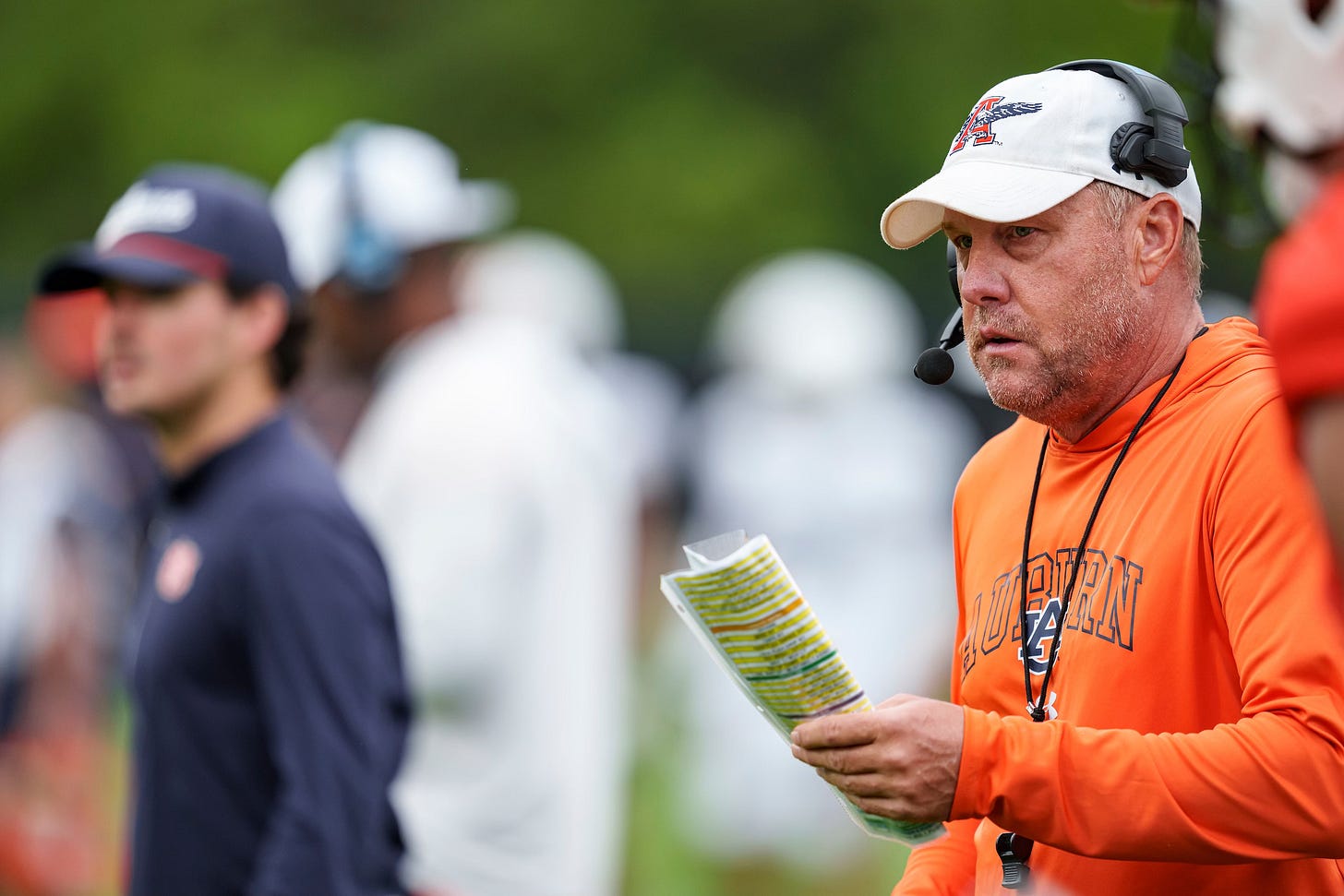How can Auburn fix its red-zone woes?
Last season, the Tigers had the SEC's lowest TD rate on trips inside the 20 since 2017. Here's where Auburn can get better at finishing drives.
AUBURN — Last week, before the Regions Tradition Celebrity Pro-Am in Hoover, Hugh Freeze laid out a simple yet cutting truth about his Auburn football team.
Since he arrived on the Plains, Freeze has constantly talked about needing to improve the talent level in order to compete for championships again. He personally believes that it will take three strong recruiting classes to do that. So far, he’s gotten two.
But going through that process doesn’t excuse what Auburn put on the field last fall.
The Tigers went 5-7, putting up their fourth straight losing campaign — the longest streak for the program in more than 70 years. The biggest blow for Freeze and his team? Auburn went 0-3 at home against three teams that it beat on the road a year earlier: Cal, Arkansas and Vanderbilt. None of those teams recruit as well as Auburn.
Combine those losses with a pair of dropped games from very winnable second-half positions against comparable opponents — Oklahoma and Missouri — and you’ve got a season that fell short of expectations, even for Year 2 of a recruiting-based rebuild.
“We could have had four more wins last year even with the talent gap,” Freeze said, per friend of the newsletter Nathan King at Auburn247. “You now add more talent to it, and hopefully better play at certain positions, that gives me reason for even more optimism. We have to coach them well and be excellent in those critical downs and situations. But there is reason for optimism.”
Let’s dig into that third sentence, specifically the “critical downs and situations” part.
Auburn’s defense, given DJ Durkin and his track record at previous stops, was ahead of schedule in his first season in charge. The Tigers finished No. 18 nationally in yards allowed per play and No. 27 in points allowed per game. Considering the amount of true freshmen that logged heavy snaps, Auburn built a good foundation on that side of the ball last fall.
The biggest defensive issue, of course, was Auburn’s inability to get off the field on third downs — and specifically third-and-longs. We’ll break down that issue in a future newsletter this offseason, because it’s one that prevented the Tigers from being a truly strong defense last season.
There were a lot more problems on the offensive side of the ball, which is Freeze’s area of expertise. Auburn put up one of its biggest passing seasons in program history in terms of pure yardage, but it only scored a paltry 18.6 points per game against power-conference competition. That was 2012 levels of bad for Auburn.
When a team is good at moving the ball — Auburn ranked No. 9 nationally in total yards per play, only falling to No. 28 when looking at just power-conference games — but is towards the bottom of the barrel in scoring, it’s a finishing problem.
Freeze noted last week that the “kicking game” was a big issue for Auburn last season, and he was right. Without Alex McPherson, the Tigers went from a team that didn’t miss a single field goal in 2023 to the worst in the country in 2024.
But there’s two important things to consider here: First, Auburn’s problems on special teams weren’t just missing easier field goals. The Tigers ranked No. 128 out of 131 FBS teams in starting field position largely because of how much it struggled in the return game. Penalties and mental mistakes were rampant.
Second, as much as it’s important to have a trustworthy kicker, the ultimate end result for any offense should be to put touchdowns on the board, not field goals. Football can often come down to which team does the best with its scoring opportunities. “Field goals are failures” feels harsh, but it’s not a bad mindset to have.
And the 2024 season was downright disastrous for Auburn when it had scoring opportunities. The Tigers raced No. 122 nationally in red-zone touchdown rate, which is the percentage of times an offense’s trips inside the opponents’ 20 finished with the ball in the end zone.
Auburn only scored 20 touchdowns on its 41 red-zone visits. In SEC games alone, the results were even worse: Just eight touchdowns on 24 trips. That 33.3% touchdown percentage was the worst mark for an SEC team in a single season since 2017 Tennessee — the 0-8 finale for Butch Jones and, in the interim, Brady Hoke.
But it’s not like Auburn was dreadful with its red-zone opportunities in 2023, when Freeze had less talent at his disposal and the Tigers weren’t as good between the 20s. Auburn ranked a solid 40th in red-zone touchdown percentage that season and fifth among SEC teams in league play.
So, what happened? How did Auburn regress from a decent red-zone offense to one of the worst in the country? And what could be done in 2025, with a new-look cast of characters, to flip it around and help the Tigers get some much-needed wins?
For this piece, I went back and looked at all 16 of Auburn’s red-zone trips in SEC play that didn’t end in touchdowns to see what went wrong.
(Why just the conference games? Well, most of the non-con competition wasn’t a good barometer of what Auburn truly was on offense — and the Tigers only got into the red zone twice in that ugly Week 2 loss to Cal, scoring touchdowns both times.)
Here are four reasons behind Auburn’s red-zone woes in 2024 and how the Tigers could address them in a make-or-break 2025 for Freeze and his program.


